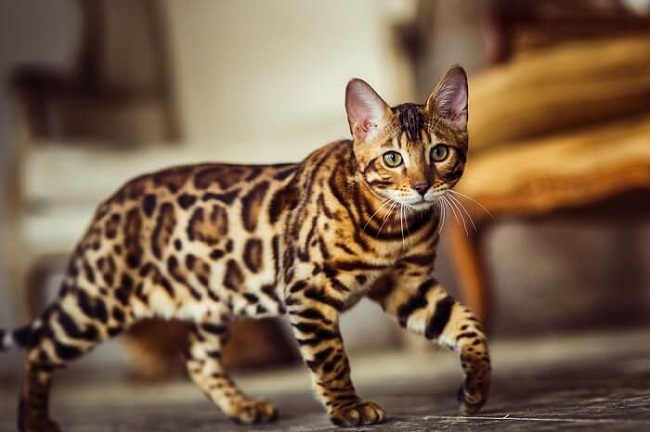Domestic cats come in a wide array of colors, patterns, and sizes, some bearing a remarkable resemblance to their wild counterparts, especially leopards.
If you’ve ever dreamed of owning a mini-leopard without the wild behavior, then this guide is for you. We’ll explore several breeds of domestic cats that share the striking spots and rosettes typically associated with leopards.

Breeds of Cat That Looks Like a Leopard
Here are some of the breeds of cats that look like a leopard:
Read Also:
The Bengal Cat
Arguably the most popular cat breed that looks like a leopard, Bengals are known for their striking coat patterns, muscular bodies, and playful nature. They boast spots, rosettes, and marbling that mimic the aesthetic of a wild leopard.
The Savannah Cat
The Savannah cat is another breed that mimics the leopard’s exotic beauty. Known for their large size, long legs, and unique spotted coat, Savannahs combine the allure of the wild with the temperament of a domestic cat. Their vibrant personalities and playful behavior add to their appeal.
The Ocicat
Don’t let the wild look fool you – the Ocicat is 100% domestic. This breed sports a wild appearance, with large spots spread across its body, but lacks any actual wild cat DNA. They are known for their athletic build, sociability, and adaptability.
The Serengeti Cat
This breed was explicitly developed to resemble a miniature version of a Serval, a wild cat known for its spots. Serengeti cats feature long legs, round-tipped ears, and a patterned coat, giving them a wild, leopard-like appearance.
Understanding Leopard-like Cat Behavior
Despite their wild appearance, these cat breeds are domestic and can be loving, affectionate pets. However, many of these breeds are energetic and require mental stimulation and physical exercise.
Caring for Leopard-like Cats
These breeds often need more care and attention than your average domestic cat. They may require more playtime, a larger living space, and a diet that caters to their unique nutritional needs.
Health Considerations for Leopard-Like Cats
As with any breed, certain health conditions are more prevalent in leopard-like cats. For example, Bengal cats are more prone to developing progressive retinal atrophy (PRA), an eye condition. Regular vet check-ups and screenings can help ensure your cat’s well-being.
Training Your Leopard-Like Cat
Leopard-like cats are known for their high intelligence and can often be trained to perform tasks or tricks. Clicker training and positive reinforcement can be beneficial for these breeds.
Socialization of Leopard-Like Cats
These breeds are typically social and enjoy the company of their human family members. Early socialization can help ensure they grow up to be friendly and well-adjusted adults.
Grooming Your Leopard-Like Cat
Most leopard-like cats have short coats that are easy to care for. Regular brushing can help to keep their coats shiny and healthy, and reduce shedding.
Ethical Breeding Considerations
Some controversy surrounds the breeding of wild-looking cats. Always ensure that you’re purchasing your pet from a responsible, ethical breeder who prioritizes the animals’ health and well-being over aesthetic traits.
Choosing the Right Leopard-Like Cat for You
Consider your lifestyle, home environment, and available time when choosing your pet. Some leopard-like breeds may require more attention, exercise, or specialized care than others.
Read Also:
Conclusion
Owning a cat that looks like a leopard allows you to experience a touch of the wild from the comfort of your home.
These unique felines not only offer striking aesthetics but also boast dynamic personalities that can bring a whole new level of feline charm to your life.
























